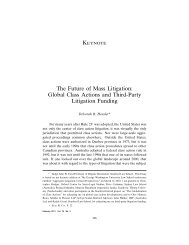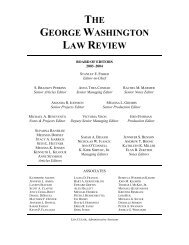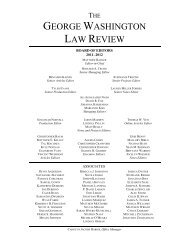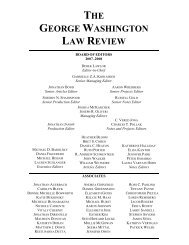View PDF - The George Washington Law Review
View PDF - The George Washington Law Review
View PDF - The George Washington Law Review
Create successful ePaper yourself
Turn your PDF publications into a flip-book with our unique Google optimized e-Paper software.
2010] Derailing Penn Central 905<br />
lete. 159 Recovery under the theory that a regulation has violated one’s<br />
right to due process has always been difficult. <strong>The</strong> Court held in Village<br />
of Euclid v. Ambler Realty Co. 160 that, in applying rational basis<br />
review, a regulation would only be found unconstitutional if it is<br />
“clearly arbitrary and unreasonable, having no substantial relation to<br />
the public health, safety, morals, or general welfare.” 161<br />
In recent times, however, success on substantive due process<br />
claims has become virtually impossible because the Court has accorded<br />
substantial deference to the political branches when it comes<br />
to evaluating economic legislation, including zoning regulations. 162<br />
<strong>The</strong>re exists “a broad consensus across a wide ideological spectrum<br />
that federal courts should not employ the Due Process Clause to evaluate<br />
the wisdom of economic regulation. This has eliminated the doctrinal<br />
foundation for due process review of zoning in federal<br />
courts.” 163 Instead of requiring that the regulation be “clearly arbitrary<br />
and unreasonable,” 164 the courts are adopting even more lenient<br />
standards, such as “grave unfairness,” 165 “shock the conscience,” 166 or<br />
“truly irrational.” 167 In fact, due process land use challenges are the<br />
least likely to succeed. 168<br />
It is uncontested that applying a heightened means-ends analysis<br />
in regulatory takings would produce some benefits, such as exposing<br />
the government’s potential ulterior motives for enacting regulation. 169<br />
R.S. Radford contends that “arguments against the substantial advancement<br />
test, heightened scrutiny of takings claims, and the regulatory<br />
takings doctrine itself all share a common origin: an anachronistic<br />
yearning for expansive governmental authority over individuals and<br />
their property, untrammeled by meaningful constitutional re-<br />
159 See Lingle v. Chevron U.S.A. Inc., 544 U.S. 528, 542 (2005) (noting that the “substantially<br />
advances” test has “some logic in the context of a due process challenge”).<br />
160 Vill. of Euclid v. Ambler Realty Co., 272 U.S. 365 (1926).<br />
161 Id. at 395.<br />
162 See J. Peter Byrne, Due Process Land Use Claims After Lingle, 34 ECOLOGY L.Q. 471,<br />
474–75 (2007).<br />
163 See id.<br />
164 Vill. of Euclid, 272 U.S. at 395.<br />
165 <strong>George</strong> <strong>Washington</strong> Univ. v. District of Columbia, 318 F.3d 203, 209 (D.C. Cir. 2003).<br />
166 United Artists <strong>The</strong>atre Circuit, Inc. v. Twp. of Warrington, 316 F.3d 392, 394 (3d Cir.<br />
2003).<br />
167 Chesterfield Dev. Corp. v. City of Chesterfield, 963 F.2d 1102, 1104–05 (8th Cir. 1992).<br />
168 See Byrne, supra note 162, at 478.<br />
169 Cf. Dews v. Town of Sunnyvale, 109 F. Supp. 2d 526, 571 (N.D. Tex. 2000) (finding a<br />
town’s building restrictions racially motivated by applying the test for discriminatory intent<br />
under the Equal Protection Clause).









